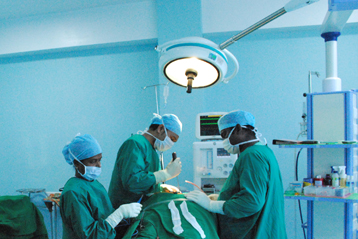
Neck Pain
The neck is located between the head and the shoulders. Because of its location and range-of-motion, it is often left unprotected and subject to injury.Neck pain can result from many different causes–from injury, to age-related disorders, or inflammatory disease.
Causes of neck pain and problems may include the following:
- Injury (damage to the muscles, tendons, and/or ligaments)
- Herniated cervical disk
- Arthritis (i.e., osteoarthritis, rheumatoid arthritis)
- Cervical disk degeneration
- Congenital (present at birth) abnormalities of the vertebrae and bones
- Tumors
How is Neck Pain Diagnosed?
In addition to a complete medical history and physical examination, diagnostic procedures for neck pain may include the following:
- Blood tests. These tests can help determine the diagnosis of inflammatory disease.
- X-ray. A diagnostic test which uses invisible electromagnetic energy beams to produce images of bones onto film.
- Magnetic resonance imaging (MRI). A diagnostic procedure that uses a combination of large magnets and a computer to produce detailed images of organs and structures within the body; can often determine damage or disease of internal structures within our joints, or in a surrounding ligament or muscle.
- Computed tomography scan (also called a CT or CAT scan). A diagnostic imaging procedure that uses a combination of X-rays and computer technology to produce horizontal, or axial, images (often called slices) of the body. A CT scan shows detailed images of any part of the body, including the bones, muscles, fat, and organs. CT scans are more detailed than general X-rays
- Electromyogram (EMG). A test to evaluate nerve function.
Treatment for Neck Pain
Specific treatment for neck pain will be determined by your doctor based on:
- Your age, overall health, and medical history
- Your diagnosis
- Extent of the condition
- Your tolerance for specific medications, procedures, or therapies
- Expectations for the course of the condition
- Your opinion or preference
Treatment may include:
- Medication (to reduce inflammation)
- Medication (to control pain)
- Rest
- Physical therapy
- Neck brace or immobilization
- Exercise
- Surgery
Back Pain
Back pain is the most common health problem nowdays. Acute back pain cause is often impossible to diagnose..
In most cases identification of the root cause is difficult. Most times patients improve with conservative management and do not require assistance. A detailed and comprehensive study helps identify patients with serious conditions so that they could be evaluated further. These conditions include infection, malignancy, rheumatologic diseases and neurologic disorders.
Causes of sudden low back pain include
- Compression fractures to the spine from osteoporosis
- Cancer involving spine
- Fracture of spinal cord
- Muscle spasm (very tense muscles)
- Ruptured or herniated disk
- Sciatica
- Spinal stenosis (narrowing of the spinal canal)
- Spine curvatures (like scoliosis or kyphosis), which may be inherited and seen in children or teens
- Strain or tears in muscles or ligaments supporting the back
Strain or tears in muscles or ligaments supporting the back
- Abnormal aortic aneurysm that is leaking
- Arthritis conditions, such as osteoarthritis, psoriatic arthritis, and rheumatoid arthritis
- Infection of spine (osteomyelitis, diskitis, abscess)
- Kidney infection or kidney stones
- Problems related to pregnancy
- Medical conditions that affect the female reproductive organs, including endometriosis,
- ovarian cysts, ovarian cancer, uterine fibroids
Diagnosis
As part of initial evaluation, physicians should perform a thorough neurologic examination to assess deep tendon reflexes, sensation and muscle strength. Peripheral pulses should also be assessed and abdomen should be palpated to search for abnormal enlargement of organs. The physician should assess joint and muscle flexibility in the lower extremities, examine the entire spine and assess stance, posture, gait and straight leg rising.
Laboratory Tests
The comprehensive evaluation may include a complete blood count, determination of erythrocyte sedimentation rate and other specific tests as indicated by the clinical evaluations. In particular, these tests are useful when infection or malignancy is considered a possible cause of a patient’s back pain.
Radiographic Evaluation
Plain-film radiography is rarely useful in the initial evaluation of patients with acute–onset low back pain. At least two large retrospective studies have demonstrated low yield of lumbar spine radiographs.
Treatment for Low Back Pain
Specific treatment for low back pain will be determined by your doctor based on:
- Your age, overall health, and medical history
- Diagnosis
- Extent of the condition
- Your tolerance for specific medications, procedures, or therapies
- Expectations for the course of the condition
- Your opinion or preference
Treatment may include:
- Activity modification
- Medication
- Physical rehabilitation and/or therapy
- Occupational therapy
- Weight loss (if overweight)
- No smoking
- Following a prevention program (as directed by your doctor)
- Surgery
- Assistive devices (e.g., mechanical back supports)
 0422 223 06 06, 9600 45 45 45, 805 6666 555
0422 223 06 06, 9600 45 45 45, 805 6666 555 Ambulance
Ambulance
 0422 223 06 06, 9600 45 45 45, 805 6666 555
0422 223 06 06, 9600 45 45 45, 805 6666 555 Ambulance
Ambulance

